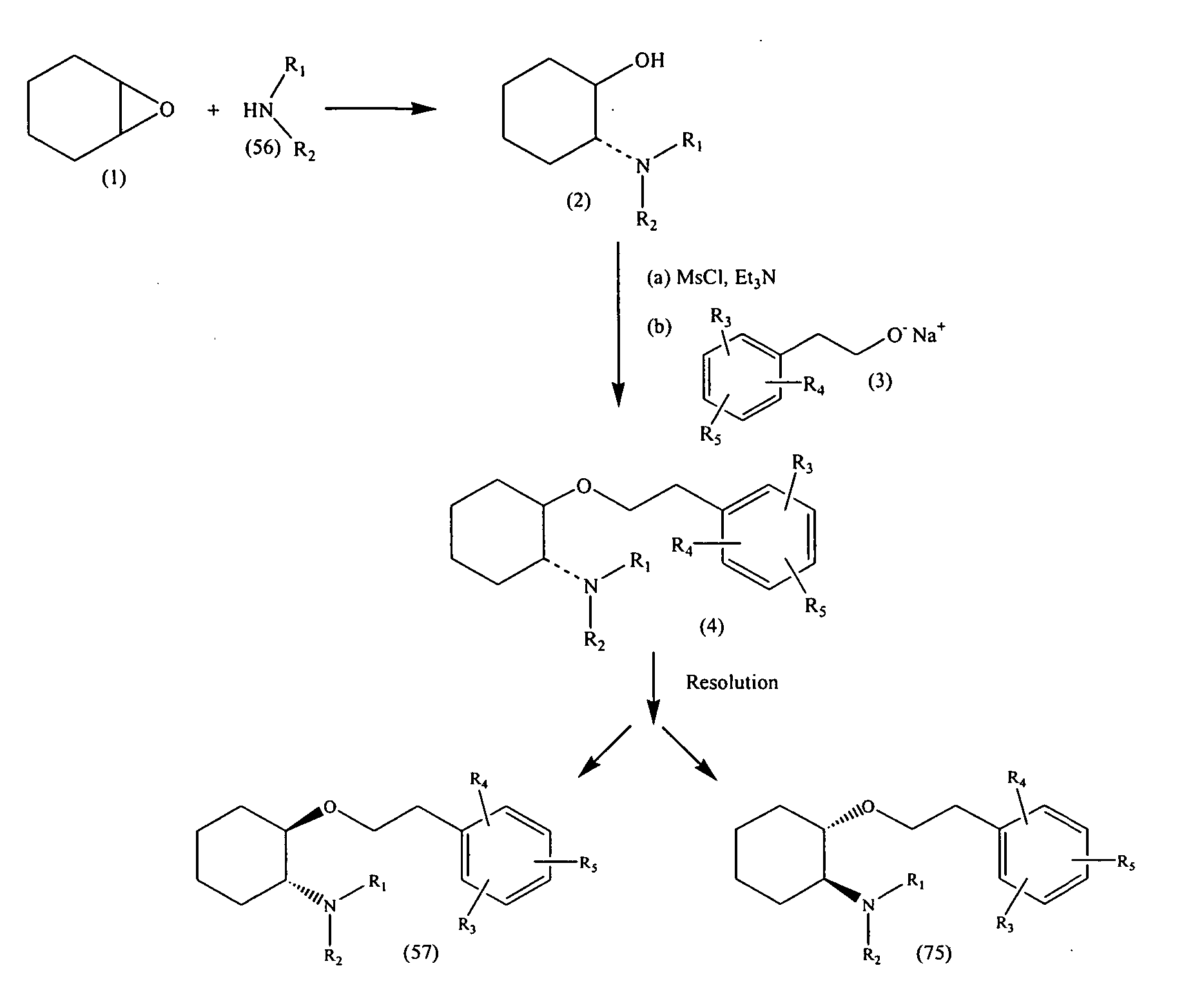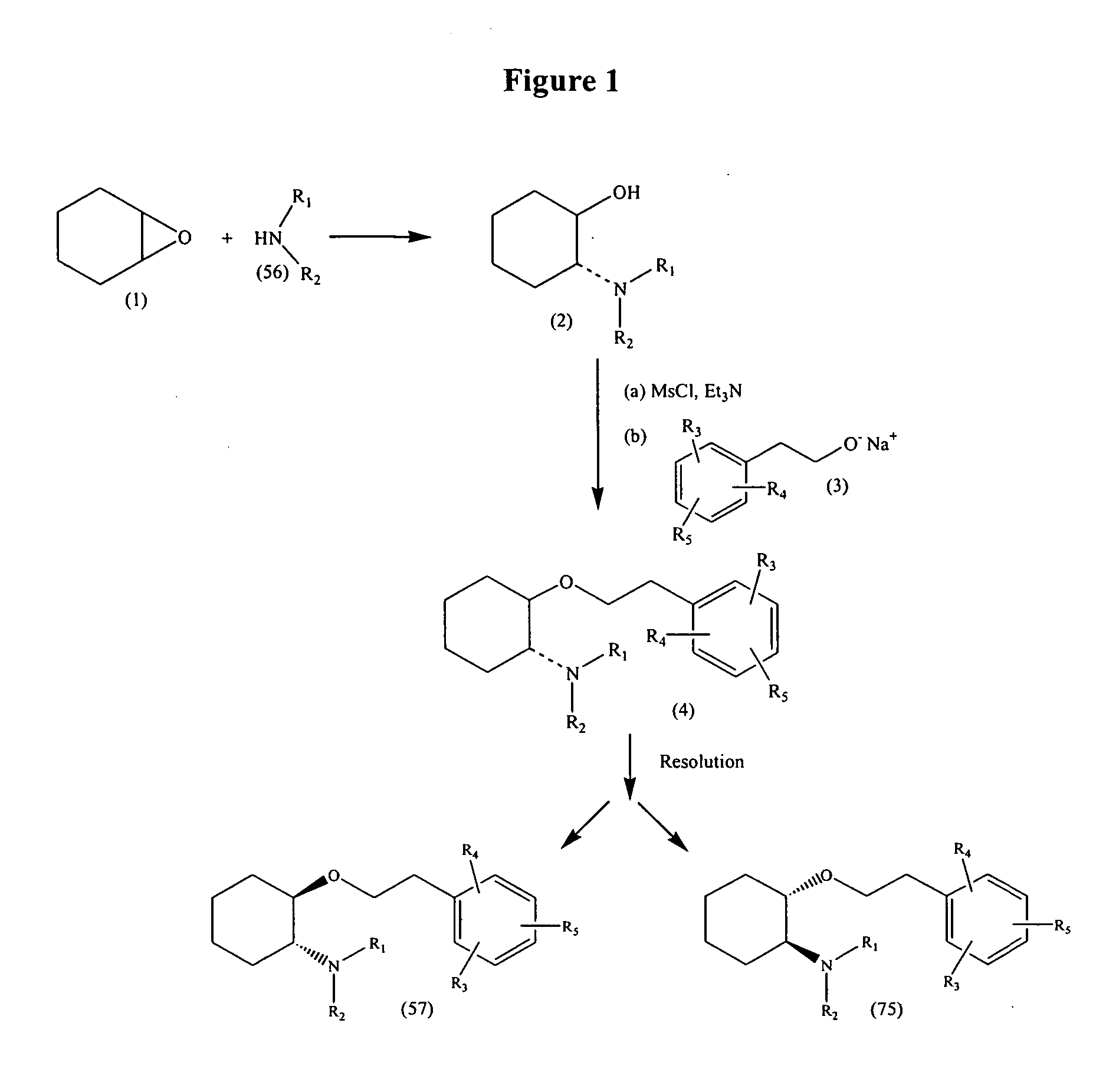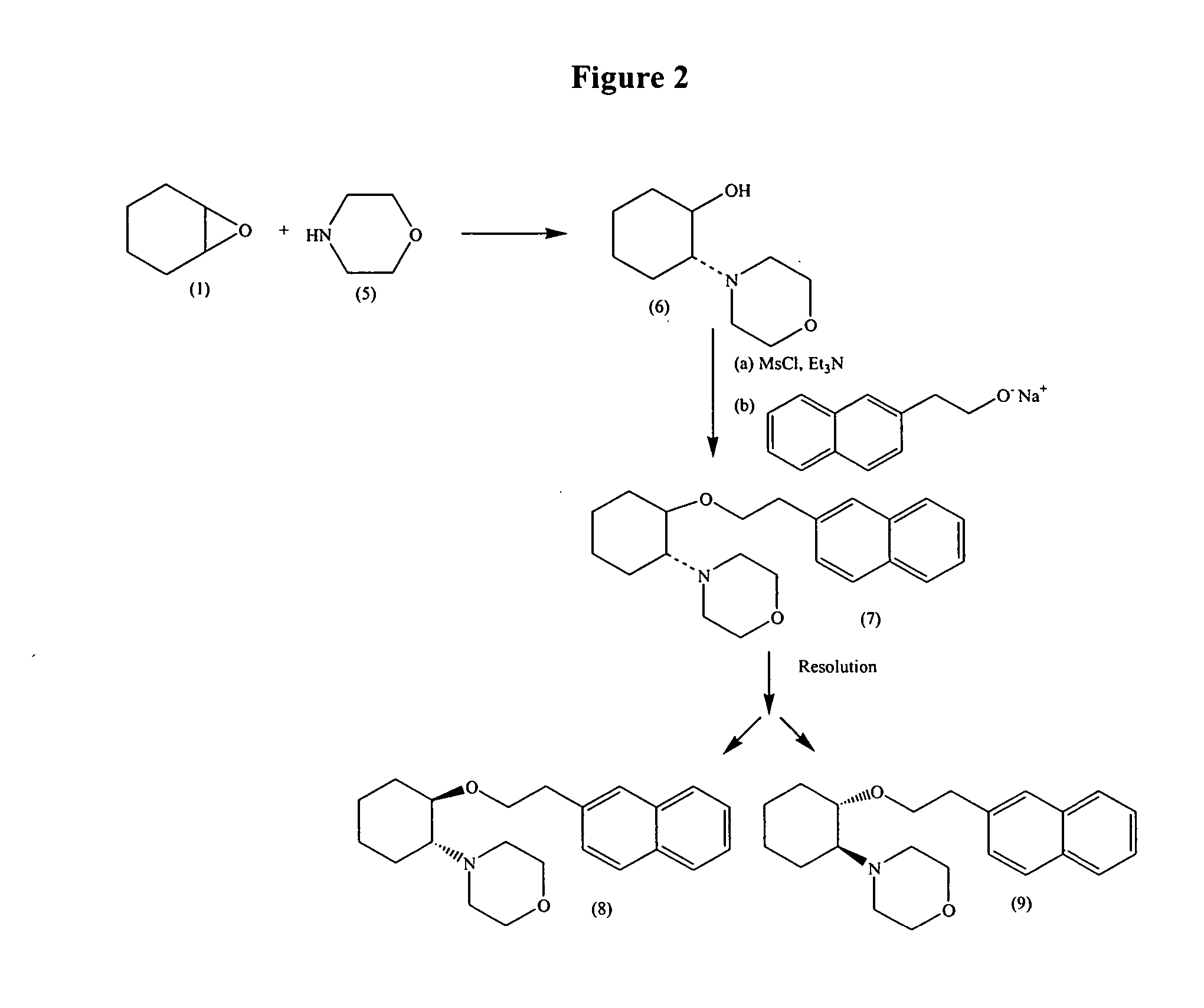Synthetic process for trans-aminocyclohexyl ether compounds
a technology of cyclohexyl ether and ether, which is applied in the preparation of amino-hyroxy compounds, organic compound preparations, organic active ingredients, etc., can solve the problems of not being practicable or cost effectiv
- Summary
- Abstract
- Description
- Claims
- Application Information
AI Technical Summary
Problems solved by technology
Method used
Image
Examples
example 1
Synthesis of (1S,2S)-3-Chloro-cyclohex-3-ene-1,2-diol (60)
Compound (59), the starting material for this reaction, was synthesized according to the procedure of Boyd et al (D. R. Boyd, N. D. Sharma, H. Dalton, D. A. Clarke, Chem. Commun., 1996, 45.) or purchased from Sigma-Aldrich. With compound (59) in hand, 5% Rh / Al2O3 (Lancaster, 3 g, 15 wt. %), THF (anhydrous, 200 ml) were charged to a hydrogenation bottle and saturated with hydrogen for about 120 minutes, using a Par hydrogenation equipment. Compound (59) (20 g, 0.13 mol) was added and hydrogenation continued at 20 psi. After about 1 hour, all starting material was consumed (by TLC analysis—10% MeOH / DCM, which indicated both product and some amount of over-reduced intermediate). There was a significant temperature increase during the reaction. After filtration through a celite plug to remove residual catalyst, the filtrate was concentrated to a light brownish solid. The crude product was recrystallized to give the desired comp...
example 2
Synthesis of (1S,2S)-Benzenesulfonic acid-3-chloro-2-hydroxy-cyclohex-3-enyl ester (61A)
To a solution of the (1S,2S)-3-chloro-cyclohex-3-ene-1,2-diol (60) in anhydrous CH2Cl2 at room temperature were added benzenesulfonyl chloride, Et3N and catalytic amount of Bu2SnO. The reaction mixture was stirred at room temperature under inert atmosphere until completion as monitored by TLC. The reaction was quenched with water, and the layers were separated. After using standard work-up and purification protocols, compound (61A) was obtained as a colorless oil.
Compound (61A): Rƒ 0.47. 1H-NMR (300 MHz, CDCl3) δ: 1.64-1.71 (m, 1H), 1.99-2.09 (m, 2H), 2.17-2.26 (m, 2H). 2.64 (s, 1H), 4.23 (dd, J=1.0 Hz, J=4.0 Hz, 1H), 4.68-4.74 (overlap dt, J=3.6 Hz, J=3.6 Hz, J=10.7 Hz, 1H), 5.91 (dd, 1H, J=2.9 Hz, J=4.5 Hz), 7.54 (t, J=8.0 Hz, 2H), 7.62-7.66 (m, 1H), 7.92 (dd, J=1.0 Hz, J=8.0 Hz, 2H). 13C-NMR (75 MHz, CDCl3) δ: 22.11, 23.68, 69.32, 79.70, 127.62, 128.19, 129.30, 129.71, 133.99, 136.48.
example 3
Synthesis of (1S,2R)-Benzenesulfonic acid 2-hydroxy-cyclohexyl ester (62A)
Reduction and dehalogenation of compound 61A to form 62A were accomplished under standard hydrogenation conditions (Pd / C, 5-20% by weight and H2 gas) in basic condition. After the reaction was deemed completed as monitored by TLC, the reaction mixture was filtered through a pad of Celite. The product (62A) was obtained as an oil after standard work-up and purification protocols.
Compound 62A: Rf 0.71. 1H-NMR (300 MHz, CDCl3) δ: 1.20-1.33 (m, 2H), 1.42-1.63 (m, 2H), 1.66-1.76 (m, 1H), 1.83-1.93 (m, 1H), 2.05 (bs, 1H), 3.79-3.823 (m, 1H), 4.61-4.66 (overlap dt, J=3.1 Hz, J=2.9 Hz, J=8.2 Hz, 1H), 7.50-7.56 (m, 2H), 7.60-7.66 (m, 1H), 7.90-7.94 (m, 2H). 13C-NMR (75 MHz, CDCl3) δ: 20.69, 21.66, 27.71, 30.20, 68.94, 83.43, 127.58, 129.20, 133.70, 137.16.
PUM
| Property | Measurement | Unit |
|---|---|---|
| stereoisomers | aaaaa | aaaaa |
Abstract
Description
Claims
Application Information
 Login to View More
Login to View More - R&D
- Intellectual Property
- Life Sciences
- Materials
- Tech Scout
- Unparalleled Data Quality
- Higher Quality Content
- 60% Fewer Hallucinations
Browse by: Latest US Patents, China's latest patents, Technical Efficacy Thesaurus, Application Domain, Technology Topic, Popular Technical Reports.
© 2025 PatSnap. All rights reserved.Legal|Privacy policy|Modern Slavery Act Transparency Statement|Sitemap|About US| Contact US: help@patsnap.com



